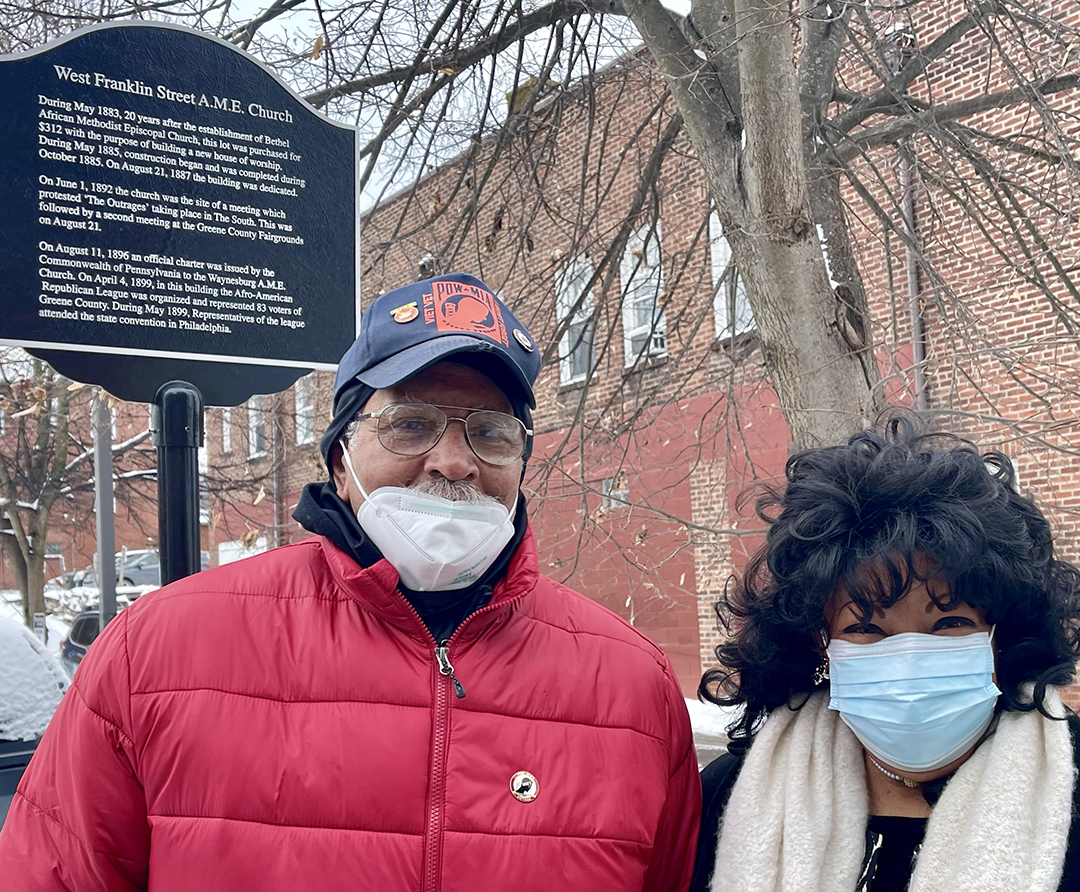It was a finger numbing 20 degrees on January 18 when people began gathering at the corner of Franklin Street and Fruit Alley in Waynesburg. Snow was cleared from the edge of the parking lot where a new pole, its signage draped in black stood waiting.
Across the street, Bill Davison of Waynesburg, masked and bundled up in a red parka and wearing his signature POW/MIA hat stood guard as the Waynesburg University media team scurried to set up cameras and microphones and turn Franklin Street into a movie set.
Promptly at noon, WU President Doug Lee and his guests, including representatives from the AME Church in Morgantown WV arrived in a university shuttle cart and students came streaming in. Those who were Lamplighters huddled together beside the microphone where President Lee would give his address and they would soon sing the hymn “Good News!” Those of us who had come from around the community greeted each other as old friends brought together to pay tribute to a long forgotten piece of Waynesburg history.
It was a long time coming, President Lee noted, a dream that lived in the heart of Bill Davison that was now about to come true.
This year’s university Martin Luther King Day commemoration took advantage of the open schedule students have on Tuesdays to turn class time into free time. Many used this time to attend services at Roberts Chapel at 11 a.m. honoring Rev. King’s commitment to the Civil Rights movement of nonviolent resistance to racial inequality that ultimately cost him his life.
Now they were here on Franklin Street to unveil the plaque commemorating not just the Bethel African Methodist Episcopal Church that stood on this corner for nearly a century, but the establishment of the church itself in 1863. The words on the plaque written by retired English teacher Marlene Bransom, originally from Pitt Gas who now lives in Pittsburgh, can only hint at the everyday lives of those of African American descent who kept the faith here.
These parishioners were the cultural heart of the African American community in Greene County, citizens whose church story stretches back to the 1830s when having a church of their own was only a dream. They persevered through those turbulent years preceding the Civil War, many secretly manning the “Underground Railroad” even as irate slave owners rode through Waynesburg looking for escapees who might sometimes be still in safe houses in town as they offered threats and rewards to the free “colored” citizens they were demanding answers from.
Later, some of them would serve in the Union Army.
These tales would come out later, in obituaries and newspaper clippings gathered by Bransom and Davison. It was hard going getting a church established, but these hardy descendants of Frontier slaves and those freed by Abraham Lincoln in the heat of the Civil War never gave up their quest for their respected, spiritual place in society that would benefit their children and grandchildren going forward.
A first lot purchased for a church on East Street in 1870 fell to foreclosure and it wasn’t until 1878 that a modest house of worship was established on Morris Street.
Davison would discover when he began tracing his own family tree thirty some years ago that his great grandfather was a trustee of the first church.
Davison and childhood friend Bransom would go on to collaborate to bring this history together and lobby for its recognition. Now, standing beside the new marker on Franklin Street, Davison reached up and did the unveiling to the applause of his many friends, President Lee and his administrative staff and students of Waynesburg University standing with him on a cold January day.
